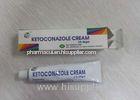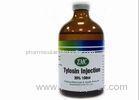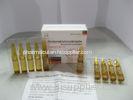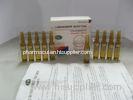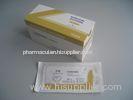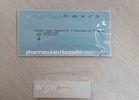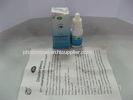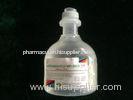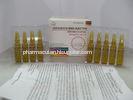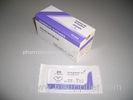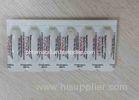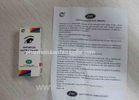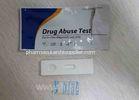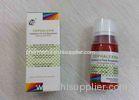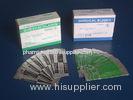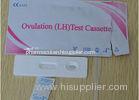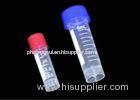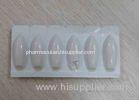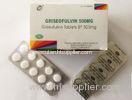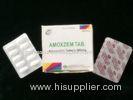|
ZHEJIANG MEDICINES&HEALTH PRODUCTS I/E CO.,LTD
|
Anti Fungal Creams Chloramphenicol Eye Ointment Antibiotics BP / USP Standard
| Place of Origin: | Guangdong, China (Mainland) |
|
|
|
| Add to My Favorites | |
| HiSupplier Escrow |
Product Detail
Chloramphenicol eye ointment 1% 4g Antibiotics Aluminium tube 1 TUBE / BOX
<
Chloramphenicol eye ointment 1% 4g Antibiotics Aluminium tube 1 TUBE / BOX
Chloramphenicol eye ointment 1% 4g
COMPOSITION:
Each gram contains:Chloramphenicol 10 mg
PHARMACOLOGICAL ACTION:
CHLORNICOL EYE OINTMENT has an antibiotic spectrum that covers Gram-positive and Gram-negative bacteria. It is primarily bacteriostatic and acts by inhibition of protein synthesis.
INDICATIONS:
Eye infections caused by susceptible organisms.
CONTRA-INDICATIONS:
Patients with known sensitivity or toxic reaction to chloramphenicol.
Minor infections or as a prophylactic agent to prevent bacterial infections.
During active immunisation and during concomitant administration with other medicines liable to depress bone marrow function.
Pregnancy and lactation.
Because of the risk of the Grey syndrome, CHLORNICOL EYE OINTMENT should never be used in newborn infants unless it may be life-saving and there is no alternative treatment.
Repeated courses and prolonged treatment should be avoided.
DOSAGE AND DIRECTIONS FOR USE:
Instill into the affected eyes two or three times a day.
SIDE EFFECTS AND SPECIAL PRECAUTIONS:
Although this preparation is an eye ointment, sufficient chloramphenicol may be absorbed to produce adverse effects.
Chloramphenicol may cause serious and sometimes fatal adverse effects and it should be discontinued on the appearance of toxic symptoms.
The most serious adverse effect is depression of the bone marrow, and it can take two different forms.
The first form is dose-related, reversible depression occurring usually when the plasma-chloramphenicol concentrations exceed 25 micrograms per mL and is characterised by morphological changes in the bone marrow, decreased iron utilisation, reticulocytopenia, anaemia, leucopenia and thrombocytopenia.
The second form is a severe, irreversible aplastic anaemia with a high rate of mortality. Bone marrow aplasia and hypoplasia may appear weeks or months after therapy.
Routine blood examinations are advisable, but will not warn of aplastic anaemia.
Haemolytic anaemia has occurred in some persons with a genetic deficiency of glucose-6-phosphate dehydrogenase activity.
A toxic manifestation - the Grey syndrome - which is characterised by abdominal distension, vomiting, ashen colour, hypothermia, progressive pallid cyanosis, irregular respiration and circulatory collapse followed by death in a few hours or days, has occurred in premature and newborn infants treated with large doses of chloramphenicol. In most cases the oral dose of chloramphenicol has been more than 25 micrograms per kg body mass. A similar syndrome has been reported in adults and older children given very high doses.
Peripheral as well as optic neuritis has been reported in patients treated with chloramphenicol, usually over prolonged periods. although ocular symptoms are often reversible if treatment is withdrawn early, optic atrophy with blindness has occurred.
Sensitivity reactions may occur. Jarisch-Herxheimer-like reactions may also occur.
Excessive blood concentrations may also occur following administration of usual doses to patients with renal failure, impaired liver function, and in premature and full-term neonates who have immature metabolic processes.
Interactions:
Chloramphenicol is inactivated in the liver and may therefore interact with medicines which are metabolised by hepatic microsomal enzymes.
Chloramphenicol enhances the effects of coumarin anticoagulants such as dicoumarol and warfarin sodium, some hypoglycaemic agents such as chlorpropamide and tolbutamide and antiepileptics such as phenytoin.
The half-life or plasma-concentrations of chloramphenicol may be affected by paracetamol, phenobarbitone, phenytoin, or rifampicin.
KNOWN SYMPTOMS OF OVERDOSAGE AND PARTICULARS OF ITS TREATMENT:
Refer to "Side-effects and special precautions".
Treatment of overdosage is symptomatic and supportive.
STORAGE INSTRUCTIONS:
Store below 15, protect from light.
KEEP OUT OF REACH OF CHILDREN.









